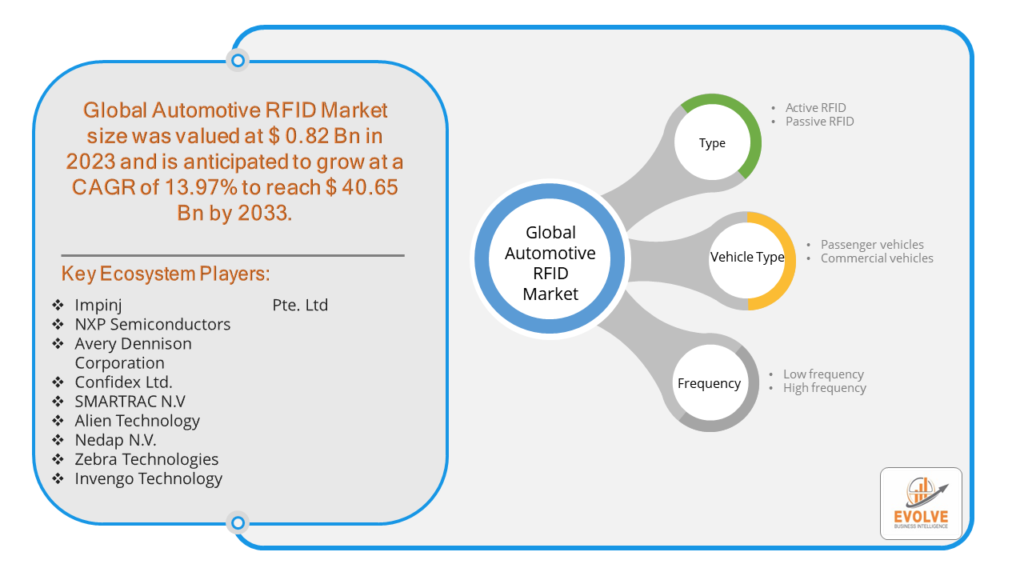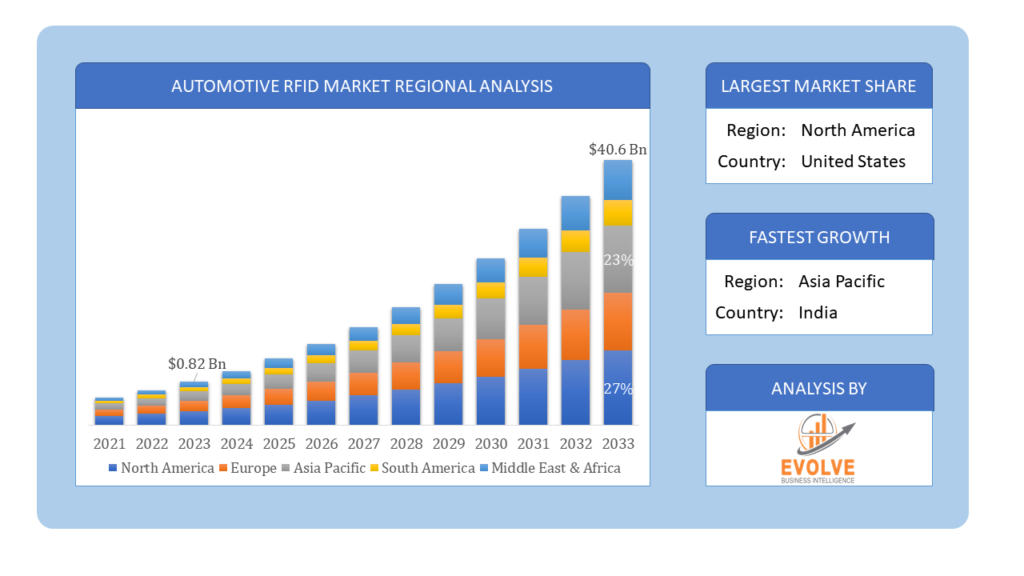Automotive RFID Market Overview
The Automotive RFID Market Size is expected to reach USD 40.65 Billion by 2033. The Automotive RFID Market industry size accounted for USD 0.82 Billion in 2023 and is expected to expand at a compound annual growth rate (CAGR) of 13.97% from 2023 to 2033. The Automotive RFID (Radio-Frequency Identification) Market involves the use of RFID technology in the automotive industry. RFID is a wireless system that uses radio waves to identify and track objects.
The Automotive RFID Market is driven by the increasing demand for improved vehicle tracking and management systems, enhanced security features, and efficient inventory management in the automotive industry. Advancements in RFID technology, such as longer read ranges and increased data storage capacity, are also contributing to the growth of this market.
Global Automotive RFID Market Synopsis
The COVID-19 pandemic had a significant impact on the Automotive RFID Market. The pandemic led to the temporary shutdown of manufacturing plants, causing delays in the production of RFID components and automotive vehicles. Restrictions on transportation and international trade affected the timely delivery of RFID components and raw materials. The need for contactless solutions grew during the pandemic, leading to increased interest in RFID technology for applications such as keyless entry, toll collection, and automated parking systems. Automotive companies sought ways to improve efficiency and reduce costs, driving the adoption of RFID for inventory management and vehicle tracking. The pandemic accelerated the digital transformation in the automotive industry, leading to a greater emphasis on technologies that can enhance efficiency and reduce human intervention.
Automotive RFID Market Dynamics
The major factors that have impacted the growth of Automotive RFID Market are as follows:
Drivers:
Ø Enhanced Vehicle Security
RFID technology is used in keyless entry systems and vehicle immobilizers, enhancing vehicle security and reducing theft rates. sRFID allows for secure access control in vehicles, ensuring only authorized individuals can start or access the vehicle. The COVID-19 pandemic has accelerated the demand for contactless technologies, including RFID, for applications such as keyless entry, toll collection, and automated parking systems. Advancements in RFID technology, such as increased read range, higher data storage capacity, and enhanced durability, make RFID systems more reliable and efficient. As RFID technology matures, the cost of RFID tags and readers continues to decrease, making it more affordable for widespread adoption in the automotive industry.
Restraint:
- Perception of High Initial Costs
The initial cost of implementing RFID systems, including purchasing tags, readers, and software, can be high, particularly for small and medium-sized enterprises (SMEs). Upgrading existing infrastructure to support RFID technology can require significant investment, which may be a barrier for some companies. RFID systems can experience interference from metal objects, liquids, and other electronic devices, which can affect the accuracy and reliability of data transmission. Depending on the type of RFID technology used (e.g., low-frequency, high-frequency, ultra-high-frequency), there may be limitations in the read range, impacting the effectiveness of the system.
Opportunity:
⮚ Growing Demand for Electric Vehicles (EVs)
As the demand for electric vehicles increases, there is a growing need for efficient supply chain management. RFID can help track and manage the inventory of EV components, batteries, and raw materials. RFID can be used in EV charging stations for user authentication, payment processing, and tracking charging sessions, enhancing the user experience. RFID technology can support the communication and data exchange needed for autonomous and connected vehicles, contributing to vehicle-to-everything (V2X) communication. RFID can be used to enhance safety features in autonomous vehicles, such as obstacle detection, traffic signal communication, and pedestrian tracking.
Automotive RFID Market Segment Overview
By Type
Based on Type, the market is segmented based on Active RFID and Passive RFID. The Active RFID segment dominant the market. In automotive manufacturing, active RFID is used to track work-in-progress (WIP) components, tools, and finished vehicles as they move through the assembly line. Active RFID tags are increasingly used in the automotive aftermarket for tracking inventory, managing spare parts, and providing faster service and maintenance operations.
By Vehicle Type
Based on Vehicle Type, the market segment has been divided into the Passenger vehicles and Commercial vehicles. Passenger car’s maximum contribution stemming from APAC. The increasing demand for passenger cars from developed and developing economies has made the segment important for the vehicle radio-frequency identification tag market.
By Frequency
Based on Frequency, the market segment has been divided into the Low frequency and High frequency. The high frequency segment held the largest share of the market. Ultrahigh-frequency RFID tags can be attached to metal products and materials, enabling real-time visibility and automated inventory management. It helps reduce human error, improve inventory, accuracy, and enhance supply chain efficiency.
Global Automotive RFID Market Regional Analysis
Based on region, the global Automotive RFID Market has been divided into North America, Europe, Asia-Pacific, the Middle East & Africa, and Latin America. North America is projected to dominate the use of the Automotive RFID Market followed by the Asia-Pacific and Europe regions.
 Automotive RFID North America Market
Automotive RFID North America Market
North America holds a dominant position in the Automotive RFID Market. North America, particularly the United States, is a leader in adopting advanced RFID technologies due to a strong emphasis on innovation and early adoption of new technologies. The region has a robust automotive industry, with major manufacturers and suppliers investing in RFID for vehicle tracking, inventory management, and security. Government regulations and initiatives promoting vehicle safety and emissions standards drive the adoption of RFID technology. High demand for connected and autonomous vehicles, as well as electric vehicles, creates opportunities for RFID applications in these segments.
Automotive RFID Asia-Pacific Market
The Asia-Pacific region has indeed emerged as the fastest-growing market for the Automotive RFID Market industry. The Asia-Pacific region, particularly China, Japan, and South Korea, is experiencing rapid industrialization and growth in the automotive sector, leading to increased adoption of RFID technology. China and India are significant manufacturing bases for automotive components and vehicles, where RFID is used to enhance production efficiency and inventory management. Japan and South Korea are known for their technological advancements and innovation in the automotive industry, driving the integration of RFID in connected and autonomous vehicles.
Competitive Landscape
The global Automotive RFID Market is highly competitive, with numerous players offering a wide range of software solutions. The competitive landscape is characterized by the presence of established companies, as well as emerging startups and niche players. To increase their market position and attract a wide consumer base, the businesses are employing various strategies, such as product launches, and strategic alliances.
Prominent Players:
- Impinj
- NXP Semiconductors
- Avery Dennison Corporation
- Confidex Ltd.
- SMARTRAC N.V
- Alien Technology
- Nedap N.V.
- Zebra Technologies
- Invengo Technology Pte. Ltd
Key Development
In March 2023, September 2023 – The AD Pure line launches with, AD Belt U9 Pure inlays and tags which are ideally suited for global apparel, retail, industry and supply-chain applications. They are compact in size and offer excellent performance on difficult-to-tag or low-detuning materials such as cardboard and plastic. Source: https://www.mordorintelligence.com/industry-reports/global-rfid-market
Scope of the Report
Global Automotive RFID Market, by Type
- Active RFID
- Passive RFID
Global Automotive RFID Market, by Vehicle Type
- Passenger vehicles
- Commercial vehicles
Global Automotive RFID Market, by Frequency
- Low frequency
- High frequency
Global Automotive RFID Market, by Region
- North America
- US
- Canada
- Mexico
- Europe
- UK
- Germany
- France
- Italy
- Spain
- Benelux
- Nordic
- Rest of Europe
- Asia Pacific
- China
- Japan
- South Korea
- Indonesia
- Austalia
- Malaysia
- India
- Rest of Asia Pacific
- South America
- Brazil
- Argentina
- Rest of South America
- Middle East & Africa
- Saudi Arabia
- UAE
- Egypt
- South Africa
- Rest of Middle East & Africa
| Parameters | Indicators |
|---|---|
| Market Size | 2033: $40.65 Billion/strong> |
| CAGR | 13.97% CAGR (2023-2033) |
| Base year | 2022 |
| Forecast Period | 2023-2033 |
| Historical Data | 2021 |
| Report Coverage | Revenue Forecast, Competitive Landscape, Growth Factors, and Trends |
| Key Segmentations | Type, Vehicle Type, Frequency |
| Geographies Covered | North America, Europe, Asia-Pacific, Latin America, Middle East, Africa |
| Key Vendors | Impinj, NXP Semiconductors, Avery Dennison Corporation, Confidex Ltd., SMARTRAC N.V, Alien Technology, Nedap N.V., Zebra Technologies and Invengo Technology Pte. Ltd.. |
| Key Market Opportunities | • Growing Demand for Electric Vehicles (EVs) |
| Key Market Drivers | • Enhanced Vehicle Security • Advancements in RFID Technology |
REPORT CONTENT BRIEF:
- High-level analysis of the current and future Automotive RFID Market trends and opportunities
- Detailed analysis of current market drivers, restraining factors, and opportunities in the future
- Automotive RFID Market historical market size for the year 2021, and forecast from 2023 to 2033
- Automotive RFID Market share analysis at each product level
- Competitor analysis with detailed insight into its product segment, Government & Defense strength, and strategies adopted.
- Identifies key strategies adopted including product launches and developments, mergers and acquisitions, joint ventures, collaborations, and partnerships as well as funding taken and investment done, among others.
- To identify and understand the various factors involved in the global Automotive RFID Market affected by the pandemic
- To provide a detailed insight into the major companies operating in the market. The profiling will include the Government & Defense health of the company’s past 2-3 years with segmental and regional revenue breakup, product offering, recent developments, SWOT analysis, and key strategies.








